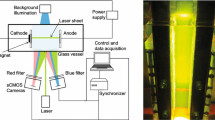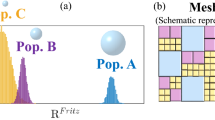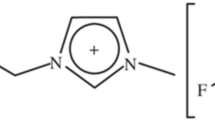Abstract
Various models have been proposed to describe the mass transfer of indicator ions to gas-evolving electrodes. For verification of the proposed models, the dependence of the mass transfer coefficient of indicator ions,k j, on the length,L e, of a gas-evolving electrode may be very useful. Experimental relations betweenk j andL e have been determined for oxygen-evolving as well as hydrogen-evolving vertical electrodes in a supporting electrolyte of 1 M KOH. Moreover, a modified hydrodynamic model, where a laminar solution flow is induced by rising bubbles, has been proposed in order to calculatek j. It has been found that this model is not useful for both types of gas-evolving electrodes. The experimental results support the earlier proposed convection-penetration model for the oxygen-evolving electrode. The solution flow near a vertical electrode, induced by rising bubbles, behaves in a turbulent manner.
Similar content being viewed by others
Abbreviations
- A e :
-
electrode surface area
- A 1 :
-
parameter defined by Equation 13
- A 2 :
-
parameter defined by Equation 14
- A 3 :
-
A 1/A 2
- A 4 :
-
parameter defined by Equation 34
- c :
-
concentration
- c s :
-
concentration in bulk of solution
- D :
-
diffusion coefficient
- d e :
-
equivalent diameter of cell compartment at the level of the working electrode
- F :
-
Faraday constant
- F B :
-
buoyant force
- F S :
-
shear force
- g :
-
acceleration due to gravity
- i :
-
current density
- k j :
-
mass transfer coefficient of indicator ion j to an electrode
- L c :
-
length of electrode
- m :
-
parameter defined by Equation 13
- m j :
-
quantity of speciesj
- M :
-
momentum flow
- ΔM :
-
change inM
- n :
-
parameter defined by Equation 13
- p :
-
parameter,x 3/4
- υ:
-
velocity of solution flow
- υs :
-
velocity of bulk solution flow
- υ1 :
-
υ defined by Equation 2
- V B :
-
volume of bubbles
- w :
-
width of a volume element
- x :
-
coordinate, distance from leading edge of electrode
- y :
-
coordinate, distance to the electrode
- z :
-
coordinate, width of electrode
- δ:
-
boundary layer thickness
- δb :
-
bubble layer thickness at the electrode
- δn :
-
Nernst diffusion layer thickness
- ε:
-
gas voidage
- ϱ:
-
density
- εav :
-
average density of a mixture of solution and bubbles in a volume element
- εs :
-
density of bulk solution
- εg :
-
density of gas
- μ:
-
viscosity
- μw :
-
viscosity of solution-gas bubble mixture at the electrode surface
- ν:
-
kinematic viscosity, ν=μ/ϱ
- ψ:
-
parameter defined by Equation 26
- av:
-
average
- b:
-
bubble layer at the surface of electrode
- B:
-
bubble-induced convection
- e:
-
electrode
- F:
-
forced convection
- fi:
-
Fe(CN) 3−6
- fo:
-
Fe(CN) 4−6
- FB:
-
combined forced and bubble-induced convection
- g:
-
gas
- max:
-
maximum
- N:
-
natural convection
- s:
-
bulk of solution
- w:
-
on the electrode surface
References
H. Vogt, in ‘Comprehensive Treatise of Electrochemistry’ (edited by E. Yeager, J. O'M. Bockris, B. E. Conway and S. Sarangapani) Plenum Press, New York and London (1983) pp. 6, 445.
L. J. J. Janssen and E. Barendrecht,Electrochim. Acta 30 (1985) 683.
L. J. J. Janssen and S. J. D. van Stralen,26 (1981) 1011.
L. J. J. Janssen and E. Barendrecht,24 (1979) 693.
L. J. J. Janssen and J. G. Hoogland,18 (1973) 543.
L. J. J. Janssen and E. Barendrecht, ‘Dechema-Monographien Band 98’, Verlag Chemie (1985) p. 463.
C. R. Wilke, C. W. Tobias and M. Eisenberg,Chem. Eng. Progr. 49 (1953) 663.
E. R. G. Eckert, ‘Introduction to Heat and Mass Transfer’, McGraw-Hill, New York, San Francisco, Toronto and London (1963) p. 186.
B. E. Bongenaar-Schlenter, L. J. J. Janssen, S. J. D. van Stralen and E. Barendrecht,J. Appl. Electrochem. 15 (1985) 537.
E. Gruber, ‘Polymerchemie’, UTB Steinhopff, Darmstadt (1980) p. 124.
D. J. Pickett, ‘Electrochemical Reactor Design’, Elsevier Scientific, Amsterdam, Oxford, New York (1977) p. 125.
W. H. McAdams, ‘Heat Transmission’, 2nd edn, McGraw-Hill, New York (1942) p. 217.
J. Newman, ‘Electrochemical Systems’, Prentice-Hall, Englewood Cliffs, NJ (1973).
A. Acrivos,Chem. Eng. Sci. 21 (1966) 343.
J. Jorné,J. Electrochem. Soc. 131 (1984) 2283.
E. R. G. Eckert and R. M. Drahe, ‘Heat and Mass Transfer’, McGraw-Hill, New York (1959) p. 153.
A. J. Geurts, private communication.
D. J. Pickett and K. L. Ong,Electrochim. Acta 12 (1974) 875.
D. J. Pickett, ‘Electrochemical Reactor Design’, Elsevier Scientific, Amsterdam (1977) p. 139.
F. N. Ngoya,Electrochim. Acta 28 (1983) 1865.
M. G. Fouad and G. H. Sedahmed,17 (1972) 665.
S. S. Kutateladze,Int. J. Heat Mass Transfer 4 (1961) 31.
T. R. Beck,J. Electrochem. Soc. 116 (1969) 1038.
M. D. Birkett and A. Kuhn,Electrochim. Acta 22 (1977) 1427.
Author information
Authors and Affiliations
Rights and permissions
About this article
Cite this article
Janssen, L.J.J. Mass transfer at gas-evolving vertical electrodes. J Appl Electrochem 17, 1177–1189 (1987). https://doi.org/10.1007/BF01023601
Received:
Revised:
Issue Date:
DOI: https://doi.org/10.1007/BF01023601




